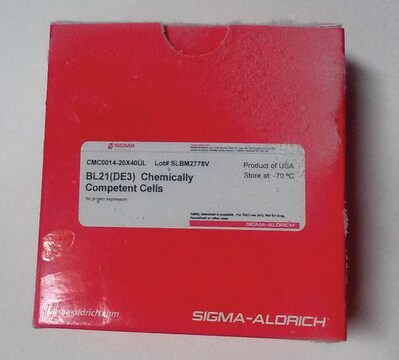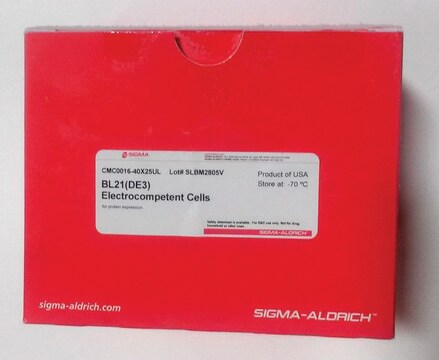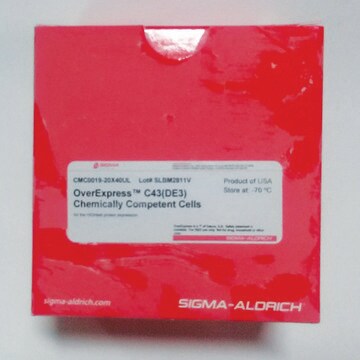CMC0014
BL21(DE3) Chemically Competent Cells
Escherichia coli, rod shaped
Synonim(y):
Competent E. coli cells
About This Item
Polecane produkty
product name
BL21(DE3) Chemically Competent Cells, for protein expression
pochodzenie biologiczne
Escherichia coli
klasa czystości
for molecular biology
tryb wzrostu
adherent or suspension
morfologia
rod shaped
metody
microbiological culture: suitable
transformacja komórek
competent cell type: chemically competent
transformation efficiency: ≥1 x 107 cfu/μg
Warunki transportu
dry ice
temp. przechowywania
−70°C
Opis ogólny
Genotype
F – ompT hsdSB (rB- mB-) gal dcm (DE3)
Zastosowanie
- to express tau 2N4R isoform (aa1–441) and the truncated tau (aa1–421) using pET19b as expression vector.
- BL21(DE3)Chemically Competent Cells has been used for the transformation and expressionof protegrin-1 (PG1) peptides.
- to express 6His-TEVsite-Hs ARF1 (17-181)-Q71L in pHis2 vector.
Cechy i korzyści
- a transformation efficiency of >1 × 107 cfu/μg.
- economical prices
- offering superior value for everyday protein expression work.
Komponenty
- BL21(DE3) chemically competent cells
- pUC 19 transformation control DNA
- recovery medium for expression
produkt powiązany
Kod klasy składowania
10 - Combustible liquids
Certyfikaty analizy (CoA)
Poszukaj Certyfikaty analizy (CoA), wpisując numer partii/serii produktów. Numery serii i partii można znaleźć na etykiecie produktu po słowach „seria” lub „partia”.
Masz już ten produkt?
Dokumenty związane z niedawno zakupionymi produktami zostały zamieszczone w Bibliotece dokumentów.
Klienci oglądali również te produkty
Nasz zespół naukowców ma doświadczenie we wszystkich obszarach badań, w tym w naukach przyrodniczych, materiałoznawstwie, syntezie chemicznej, chromatografii, analityce i wielu innych dziedzinach.
Skontaktuj się z zespołem ds. pomocy technicznej






